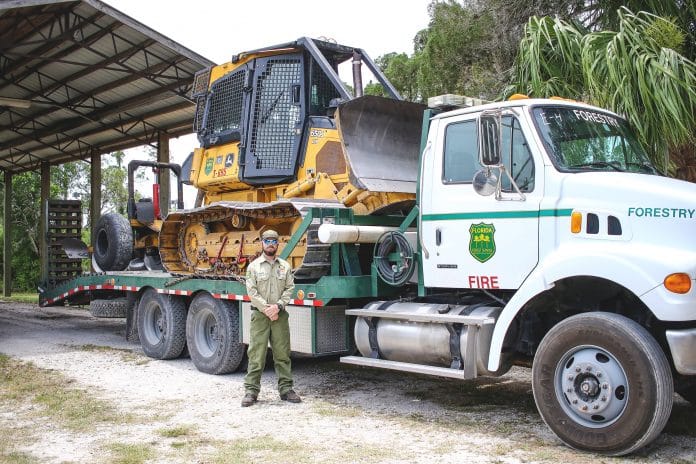Since the beginning of January 2020, over 1000 reported wildfire cases have burned over 16,000 acres. The two recent wildfires located in Santa Rosa county in the western portion of the Florida panhandle, and one in Collier County have been the largest to date.
2007 Hernando High school graduate and Local Wildland Firefighter Blake Hunter assisted with the mitigation of a Collier County wildfire. According to the National Wildfire Coordinating Group, a Wildland Firefighter undergoes rigorous training to qualify for positions at the national, state and local levels. (More information: https://www.nwcg.gov/how-to-become-a-wildland-firefighter)
Blake became interested in becoming a wildland firefighter after working with a friend who was employed as part of the Community Mitigation Assistance Team (CMAT) with the Florida Forest Service.
The US Forest Service explains that CMATs work closely with Incident Management Teams, the Forest Service, or other land management agencies and community residents and leaders to identify mitigation opportunities before a fire impacts the community.
Community Mitigation Assistance Team | US Forest Service
“That got me interested,” Blake said. “I knew I wanted to be a firefighter. I just didn’t know exactly whether it would be structural or wildland.”
When a temporary CMAT field ops position opened in 2012, Blake took that opportunity to apply. In just under two years, another opportunity opened for Blake; The Florida Forest Service was accepting experienced personnel in fire control.
Blake, having experience in heavy equipment, prescribed burning, and holding a Class B CDL license was able to extend his field training to become a Forest Ranger.
“I love it,” Blake said. “I am out in the woods almost every day, and I love helping people.”
Naples, FL
On May 14th, Blake got the call to help assist in the wildfire in Collier County known as 36th Ave SE.
The wildfire west of the Florida Panther National Wildlife Refuge was heading towards many homes and forest ranches.
“When we got to the scene, the fire behavior was extreme. It was torching trees,” Blake said. “We unloaded our bulldozers and started our initial attack by putting plow lines around the flanks and the head, stopping the forward progress of the fire. We also had multiple air resources like helicopters and airplanes, making water drops to help slow the spread of fire, and also to protect the structures.”
Wildfire Terms:
‘Head’ – Wildfire advancing in the direction of the wind; the head is where the fastest rate of spread occurs, the most heat is generated and the most damage is done. The head is the most dangerous part of the wildfire.
‘Flank’ – Sides of the wildfire between the head and the rear (left and right). Flanks tend to burn with less intensity but if the wind shifts, the flank can easily change into a head fire.
Blake’s team worked ten 16-hour days to widen and improve the original fire line. They extended the fireline using bulldozers to ensure the active wildfire had no fuel (grasses or leaf litter) to cross over.
“We do what we call a rehab ‘fire lines.’ It’s where we take our bulldozers, and we widen up the fire lines, so they’re wider and down to minimal dirt. Then we go into a monitoring and hold status where we continue to monitor the fire,” Blake said.
After the final sweep to ensure the wildfire is 100% contained, Blake and all of the active wildland firefighters did what they were sent out to do – protect the livelihood of the community.
“I enjoy my job, and I wake up every day, knowing that something exciting and new is going to happen,” Blake said. “I do get pleasure out of the homeowners and the community coming together. Coming up to us thanking us and hugging us for saving their houses. It is really a good feeling to know that I came down to help out and made a difference.”
On May 22, the 36th Ave S wildfire had been at 98% contained. That wildfire burned over 8000 acres and destroyed seven homes.
Blake explained this job is not for everyone. It’s hard work, long hours, and at times you’re in a brutal environment. However, at the end of the day, the rewards for that hard work are many. It brings a stronger connection with those on your team and the community you are there to protect.
“Do what you love and follow your dreams,” Blake said. “I was eighteen when I decided what I wanted to do as a career. This is not a job, just to have a job; this is a career you want to have that’s going to impact other people’s lives, not just your own.”

